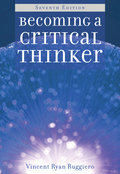
BECOMING A CRITICAL THINKER is an accessible tool for students developing their critical thinking skills, fostering success through practice in the classroom and application to daily life. INDICE: Acknowledgments. To the Instructor. 1. FUNDAMENTALS OF THINKING. What is intelligence?. What is thinking?. good thinking! THE STORY OF ALBERT EINSTEIN. Key principles of thinking. Truth is discovered, not created. Ideas are interrelated. A statement can't be both true and false at the same time and in the same way. good thinking! THE STORY OF NELLIE BLY. All people make mistakes, even experts. Ideas can be examined without being embraced. Feeling is nosubstitute for thinking. Key habits and skills of thinking. The habit of curiosity. good thinking! THE STORY OF PAUL VITZ. Skill in distinguishing facts from opinions. The habit of checking facts and testing opinions. Exercises. Quiz. 2. THE W.I.S.E. APPROACH TO THINKING. Introducing the W.I.S.E. Approach. good thinking! THE STORY OF FRANK AND LILLIAN GILBRETH. Step 1: Wonder. Step 2: Investigate. good thinking! THE STORY OF ELIZABETH LOFTUS. Step 3: Speculate. Step 4: Evaluate. Examples of Problem Solving. The uncooperative page markers. The librarian's lament. Examples of Issue Resolution. Is venting anger healthy?. What causes Yellow Fever?. An Important Relationship. A Caution About Bias.Bias toward what confirms your personal view. Bias toward familiar ideas. Bias toward your likes and against your dislikes. Exercises. Quiz. 3. IMPROVING YOUR INVESTIGATIVE SKILLS. Conducting library research. good thinking! THE RICHARD FEYNMAN STORY. Conducting Internet research. Use a search engine. good thinking! THE STORY OF LARRY PAGE AND SERGEY BRIN. Develop a resource list. Ask questions about the websites you visit. Conducting an interview. Avoiding plagiarism. Three steps to avoid plagiarism. How to correctly quote and paraphrase.Exercises. Quiz. 4. BECOMING AN INDIVIDUAL. What is individuality? Acknowledging influences. good thinking! THE STORY OF VIKTOR FRANKL. Understanding attitudes. Four empowering attitudes. Attitude 1: There's always room for improvement. Attitude 2: Criticism, including self-criticism, has value. Attitude 3: Effort is the key to success. Attitude 4: Other people are as important as I am.Recognizing manipulation. Biased reporting. Dishonest appeals to emotion. Stacking the deck. Suppressing dissent. Repetition. Resisting manipulation. Step 1: Be prepared. Step 2: Ask questions. Step 3: Be imaginative. Step 4: Check sources. Strategies for individuality. Strive for humility. Be wary of first impressions. good thinking! THE STORY OF STEPHANIE KWOLEK. Be honest with yourself. Fight confusion. Produce many ideas. Acknowledge complexity. Look for connections among subjects. Consider other viewpoints. good thinking! THE STORY OFSTANTON SAMENOW. Dare to change your mind. Base your judgments on evidence. Exercises. Quiz. 5. RECOGNIZING ERRORS IN THINKING. Four kinds of errors. Errors of perception. "Mine is better" thinking. Selective perception. Gullibility and skepticism. good thinking! THE STORY OF SYLVIA EARLE. Preconceptions. Pretending to know. Either/or thinking. False tolerance. Errors of judgment. Double standard. Irrelevant criterion. Overgeneralizing or stereotyping. good thinking! THE STORY OF MARTIN SELIGMAN. Hasty conclusion. Unwarranted assumption. Failure to make a distinction. Oversimplification. Errors of expression. Contradicting oneself. Arguing in a circle. False analogy. Irrational appeal. Errorsof reaction. Explaining away. Shifting the burden of proof. Attacking the person. Straw man. Errors can multiply. Exercises. Quiz. 6. PERSUADING OTHERS. What is persuasion? Opportunities in the classroom. Opportunities in the workplace. good thinking! THE STORY OF DOROTHEA DIX. Opportunities in the community. Opportunities in relationships. How is persuasion achieved? Respect your audience. Understand your audience's viewpoint(s). Begin on a point of agreement. Acknowledge unpleasant facts and make appropriate concessions. good thinking! THE STORY OF DALE CARNEGIE. Apply the Golden Rule. Keep your expectations modest. Strategy for persuasive writing. Step 1: State what you think about the issue and why you think it. Step 2: Consider how those who disagree might react to your view. Step 3: Arrange your ideas and write a draft of your presentation. Step 4: Check your draft for matters of style. Step 5: Check your draft for grammar, usage, punctuation, and spelling. good thinking! THE STORY OF GEORGE ORWELL. An example of persuasive writing. Strategy for persuasive speaking. Create note cards. Rehearse using a tape recorder or a camcorder. Strategy for group discussion. Exercises. Quiz. 7. APPLYING YOUR THINKING SKILLS. Thinking critically about relationships. good thinking! THE STORY OF OPRAH WINFREY. Guidelines for successful relationships. Exercises. Thinking critically about careers. good thinking! THE STORY OF FAYE ABDELLAH. A sensible approach. Exercises. Thinking critically about ethical judgments. A better basis for judgment. good thinking! THE STORY OF CHIARA LUBICH. Criteria for ethical judgment. Applying the criteria. A sample case. Exercises. Thinking critically about commercials. Bandwagon. Glittering generality. Empty comparison. Meaningless slogan. Testimonial. Transfer. Stacking the deck. Misleading statement. Exercises. Thinking critically about print advertising. Exercises. Thinking critically about television programming. Exercises. Thinking critically about movies. Characters. Setting. Plot. Theme. Exercises. Thinking critically about music. Exercises.Thinking critically about magazines. Exercises. Thinking critically about newspapers. Exercises. Quiz. Epilogue: Make the end a beginning. Works Cited. Bibliography. Index.
- ISBN: 978-0-495-90905-7
- Editorial: Heinle & Heinle
- Encuadernacion: Rústica
- Páginas: 240
- Fecha Publicación: 16/03/2011
- Nº Volúmenes: 1
- Idioma: Inglés
